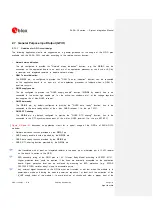
SARA-G3 series - System Integration Manual
UBX-13000995 - R06
Objective Specification
Design-in
Page 140 of 218
2.6
Audio Interface
2.6.1
Analog Audio interface
2.6.1.1
Guidelines for microphone and speaker connection circuit design (headset / handset modes)
SARA-G350 modules provide one analog audio input path and one analog audio output path: the same
paths are used for both headset and handset modes, so that basically the same application circuit can be
implemented for both headset and handset modes.
shows an application circuit for the analog audio interface in headset and handset
modes, connecting a 2.2 k
electret microphone and a 16
receiver / speaker:
External microphone can be connected to the uplink path of the module, since the module provides
supply and reference as well as differential signal input for the external microphone
A 16
receiver / speaker can be directly connected to the balanced output of the module, since the
differential analog audio output of the module is able to directly drive loads with resistance rating
greater than 14
, follow the general guidelines for the design of an analog
audio circuit for both headset and handset modes:
Provide proper supply to the used electret microphone, providing a proper connection from the
MIC_BIAS supply output to the microphone. It is suggested to implement a bridge structure:
o
The electret microphone, with its nominal intrinsic resistance value, represents one resistor of
the bridge.
o
To achieve good supply noise rejection, the ratio of the two resistance in one leg (R2/R3)
should be equal to the ratio of the two resistance in the other leg (R4/MIC), i.e. R2 has
to be equal to R4 (e.g. 2.2 k
) and R3 has to be equal to the microphone nominal
intrinsic resistance value (e.g. 2.2 k
).
Provide a proper series resistor at the MIC_BIAS supply output and then mount a proper large bypass
capacitor to provide additional supply noise filtering. See the R1 series resistor (2.2 k
) and the C1
bypass capacitor (10 µF).
Do not place a bypass capacitor directly at the MIC_BIAS supply output, since proper internal bypass
capacitor is already provided to guarantee stable operation of the internal regulator.
Connect the reference of the microphone circuit to the MIC_GND pin of the module as a sense line.
Provide a proper series capacitor at both MIC_P and MIC_N analog uplink inputs for DC blocking (as
the C2 an C3 100 nF Murata GRM155R71C104K capacitors in
). This provides a
high-pass filter for the microphone DC bias with proper cut-off frequency according to the value of
the resistors of the microphone supply circuit. Then connect the signal lines to the microphone.
Provide proper parts on each line connected to the external microphone as noise and EMI
improvements, to minimize RF coupling and TDMA noise, according to the custom application
requirements.
o
Mount an 82 nH series inductor with self resonance frequency ~1 GHz (e.g. Murata
LQG15HS82NJ02) on each microphone line (L1 and L2 inductors in
Formatted:
English (U.S.)
Formatted:
English (U.S.)






























